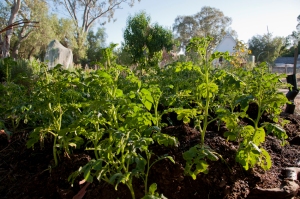 A busy time this month as you make the most of the warm days and not so cool nights and get your veges in, especially the leafy greens which will feed you right through winter if planted now and into May. It’s also a great time for planting herbs and perennials, shrubs and trees, and for striking cuttings of herbs and many other edible plants. And plant your garlic now if you haven’t already.
A busy time this month as you make the most of the warm days and not so cool nights and get your veges in, especially the leafy greens which will feed you right through winter if planted now and into May. It’s also a great time for planting herbs and perennials, shrubs and trees, and for striking cuttings of herbs and many other edible plants. And plant your garlic now if you haven’t already.
Also time to take stock. Many plants will have struggled to survive this summer, so think about which ones might need to be moved or given permanent protection ahead of next year’s heat. You can do this through autumn and winter.
Even though many areas have had an inch or so of rain, it won’t even make a dent in the subsoil (and even topsoil) yet, because of such a long, hot dry. Especially areas which haven’t been cropped. You may have to ‘top up’ with a follow up water after the next rain event. More importantly, give your garden beds a bit of TLC before you plant. Chop up any disease free plant material, add dolomite lime (the advantage of Magnesium as well as Calcium), rock dust and quality compost and dig that through before planting. Some beds may need a green manure if they have been constantly cropped with heavy feeding crops. Incorporate mulches after they have broken down, use worm castings and juice; keep feeding your soil and the soil will feed you!
 It’s been hard to find room in the garden for autumn/winter planting because of the unusual summer – tomatoes, pumpkins, beans and zukes are still flowering. No doubt the first frost will be here this month (fingers crossed it stays away a bit longer!) but the frosts do us a favour by killing bugs like red legged earthmite and minimising the spread other pests and disease. Keep on top of the slaters and snails though.
It’s been hard to find room in the garden for autumn/winter planting because of the unusual summer – tomatoes, pumpkins, beans and zukes are still flowering. No doubt the first frost will be here this month (fingers crossed it stays away a bit longer!) but the frosts do us a favour by killing bugs like red legged earthmite and minimising the spread other pests and disease. Keep on top of the slaters and snails though.
Give your perennials a feed of worm juice and/or seaweed solution. Think about making compost with the residues of harvest and those beautiful autumn leaves. It is also possible to make a lovely seedraising or potting mix with autumn leaves alone – chop them up, mix with a handful or two of lime, water and fork it all about. Give the mix a regular toss and water and you’ll have a batch in no time. The first application of biodynamic preps for the year – BD500 followed by BD501 is also a job for this month.
On the cosmic front – two eclipses this month – lunar and solar. Brian Keats suggests a delicate time weatherwise. Watch for extreme weather.
Gardening Dates for temperate areas of SE Australia:
Note that (s) means sow as seeds and (p) means plant as seedlings.
Leaf Days: 1, 8-10, 17-20, 26-28: amaranth (s,p), bok choi (s,p), brussel sprouts (p), cabbage (p, s), kale (s,p), celery (s,p), coriander (s,p), endive (s,p), mibuna (s,p), mizuna (s,p), orach (p), rocket (s,p), tat soi (s,p), lettuce (s,p), mustard (s,p), silverbeet (s,p), chard (s,p), spinach (s,p), chives (s,p), garlic chives (s,p), dill (s,p), parsley (s,p)
Fruit Days: 1-3, 10-13, 20-22, 28-30: broad beans (s, p), mustard (s,p), peas (s,p), snopeas(s,p)
Root Days: 3-5, 13-15, 22-24, 30 : beetroot (s,p), carrots (s,p), celeriac (s,p), fennel (s,p), garlic (s,p), garlic chives (s,p), bunching onion (s,p), kohlrabi (s,p), leek (s,p), parsnip (s,p), radish (s,p), daikon radish (s,p), swede (s,p), turnip (s,p)
Flower Days: 1, 7-9, 16-18, 26-28: broccoli (s,p), borage (s,p), cauliflower (p), all flowers (poppies, lupins, calendula, etc) (s,p)
Moon Opposite Saturn (considered a good date for sowing seeds, applying preps and planting, or 48hrs either side): 25
Node Days (avoid planting if you can): 1, 15, 28
Apogee (moon furthest from earth; less lunar influence):9
Perigee (moon clostest to eath; more lunar influence): 23
New Moon/Full Moon: 29(solar eclipse)/15(lunar eclipse)
Moon descending: 1-5, 19-30
Moon ascending: 5-19
Apply soil fertilisers, compost: 19-30 best then 3-5
Prune, take cuttings, plant seedlings: 21-23 best then 20, 26-28, 30, 3-5
Apply foliar fertilisers: 5-15
Graft: 5-8 then 15-18
Dates are a guide for these particular crops. Timing will vary from region to region (particularly with climate change) and even within a garden’s own microclimates. Of course, rainfall, weather conditions and your own schedule will influence when you garden.